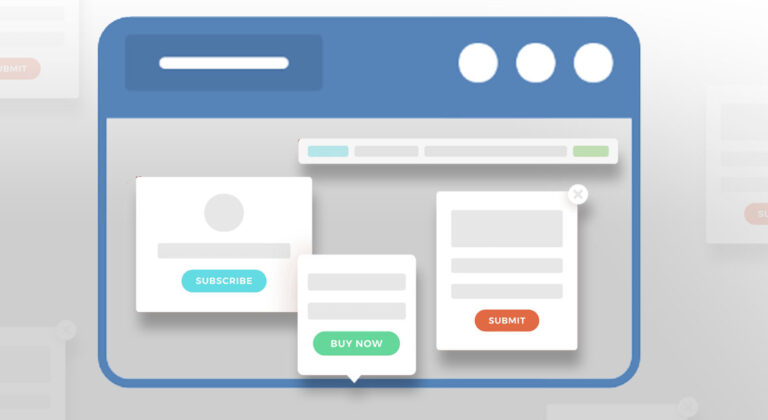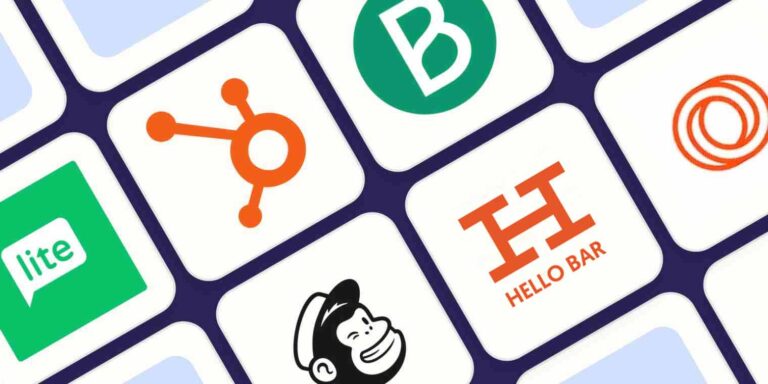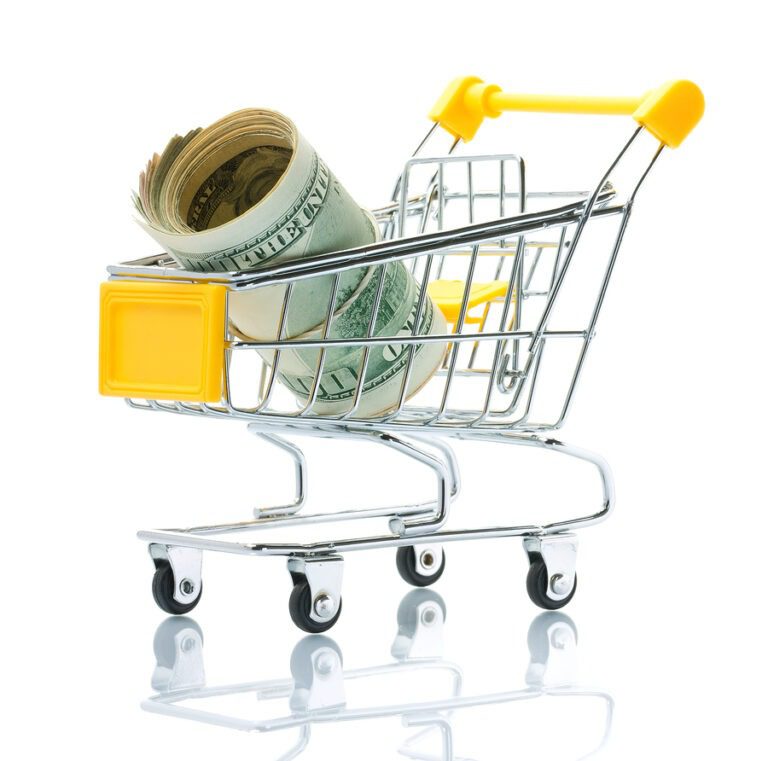19 Abandoned Cart Email Best Practices to Boost Conversions

I hope you enjoy this blog post. If you want Hello Bar to grow your leads, click here.
Author:
Ryan Bettencourt
Published
August 1, 2024

Have you ever gotten frustrated in a brick-and-mortar store and left your full shopping cart in the aisle before storming out? This same scenario happens online, where the average cart abandonment rate is 70.19% across all industries.
Unlike in a physical store, you don’t have to restock the items, but you need a strategy to recapture those potential sales.
That’s where abandoned cart emails come in to encourage customers to complete their purchases. However, knowing abandoned cart email best practices is essential.
So, how do you write an effective abandoned cart email? That’s what we’ll cover today.
What is an Abandoned Cart Email?
An abandoned cart email is an automated email sent to a lead who has put items in their virtual shopping cart but left the site without checking out. It reminds them about their abandoned item or items and invites them to return.
What is an Abandoned Cart Email Conversion Rate?
An abandoned cart email conversion rate refers to the percentage of consumers who receive these emails and convert on the opportunity to buy the neglected items.
According to a recent study, abandoned cart email flows have an average conversion rate of 3.66%. The average is double for some leading industries, like food and beverages, sports goods, and apparel.
Avoid People Abandoning Their Shopping Cart Using Hello Bar
Although you can always send an abandoned cart email (and we’re going to show you how), it’s easier to keep people from abandoning their items in the first place. A Hello Bar can help you reduce lost conversions and rescue revenue.
An exit popup can work well as part of your abandoned cart email sequence. Create your Hello Bar exit popup, then assign it to your checkout page. That way, people reading your blog or browsing your product pages would not see the popup.
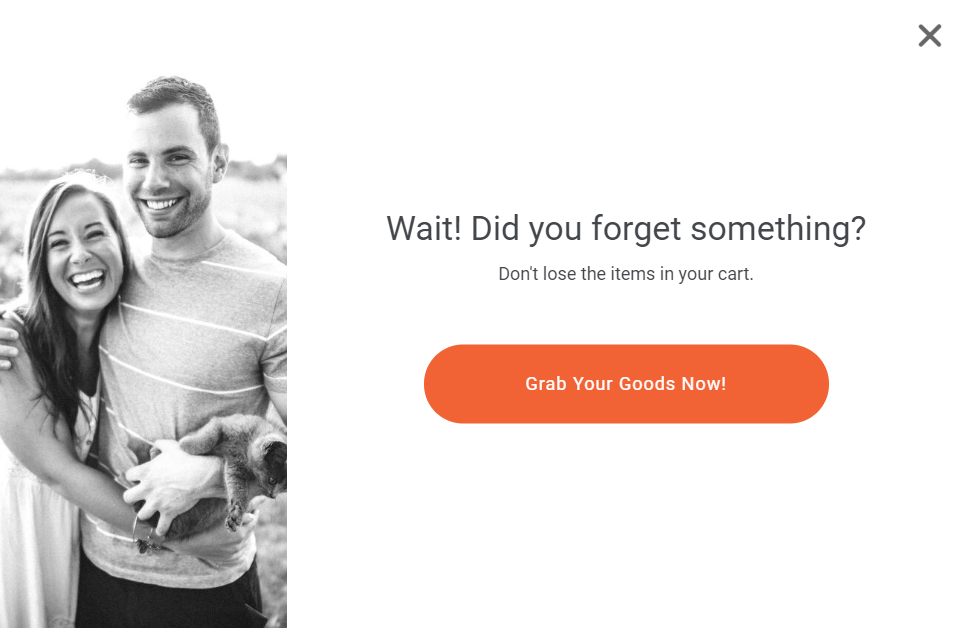
Your visitor might think twice about leaving your site. It’s the fear of missing out.
What are the Most Common Reasons People Abandon Their Shopping Carts?
According to a Statista study, there are several reasons for shopping cart abandonment. The top three are related to high extra costs, account creation requirements, and trust issues with credit card information.
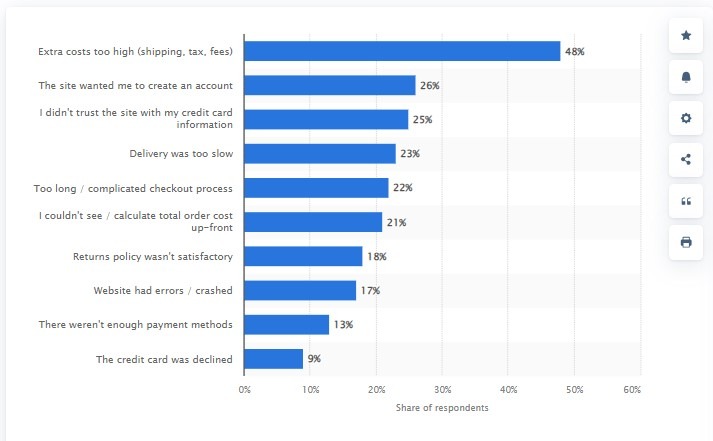
You can see from the list above that many of these issues are preventable. For instance, you can correct complicated website navigation, website timeouts, poor delivery options, and overlong checkout processes on your end.
You May Also Like:
- How to Generate Leads from Email Marketing: 11 Ways
- How To Drive Lead Nurturing Campaigns After Email Acquisitions
The 3 Basic Elements of an Effective Abandoned Cart Email
People will abandon their shopping carts no matter how perfectly you design your website. That’s just part of ecommerce marketing. But that doesn’t mean you can’t bring them back.
Ecommerce email marketing isn’t just about reaching out to your subscribers before they buy. It’s also an effective way to re-engage consumers who have interacted with your site, such as placing items in a shopping cart, without following through.
To write an effective and personalized abandoned cart email, make sure you follow email marketing best practices by including the following features.
1. Compelling Subject Line
The first hurdle is convincing your customer to open the email. Use compelling, urgent language without sounding too salesy.
Consider CTAs like these:
- Did you forget something?
- Are you still interested in [product name]?
- You left [product name] in your cart!
- Hey [Name], come back and see us!
They’re friendly but not overly promotional.
2. Visual of the Abandoned Item(s)
Remember the adage, “Show, don’t tell”? It applies when creating fantastic abandoned cart emails. You want your prospective customers to see what they’re missing.
Including high-quality product images or videos of the item in the online shopping cart can help improve conversion rates. You’re engaging your prospect visually, which can result in an increased desire for the product in question.
If multiple items are in the cart, you can feature just one or show images of all of them. Ensure you include a compelling product description with the image(s).
3. Strong Call To Action
We talk a lot about calls to action here on the Hello Bar blog — and for good reason. They’re one of the most critical factors impacting conversions today.
Your call to action needs to tell your readers exactly what you want them to do. You get bonus points if the CTA includes colorful or inviting language to draw in the reader.
Consider letting your CTA reflect your subject line, such as the examples we listed above. “Grab your goods” or “Don’t Miss Your Chance” work well. A/B test your CTAs to identfy which works best in your abandoned cart email.
19 Abandoned Cart Email Best Practices and Tips
Writing an abandoned cart email is all about psychology. You want your online shoppers to do something that puts money in your pocket, so you have to think like a consumer.
What will convince your target audience to go back and complete the checkout process? What words, phrases, or images will be compelling enough to overcome all objections and questions?
Those are hard questions to answer, but we will share our 19 best practices for abandoned cart emails. Use them in your ecommerce email marketing campaign to spark more conversions.
1. Make Your Abandoned Cart Emails Ultra Specific
Never waste your reader’s time, especially when looking to convert them to customers. Get right to the point in your email by asking the reader to return to the checkout page.
Include a brief headline, an image of the product(s), a brief description, and a call to action. That’s all you need. If you throw in too much copy, you’ll overwhelm the reader — and probably tank your chances of converting them.
2. Use Compelling Visual Features in Your Abandoned Cart Emails
Visuals help the reader connect to your message more effectively. For instance, you might use a stock image of a “sad” shopping cart. Just make it small so it doesn’t overwhelm the page.
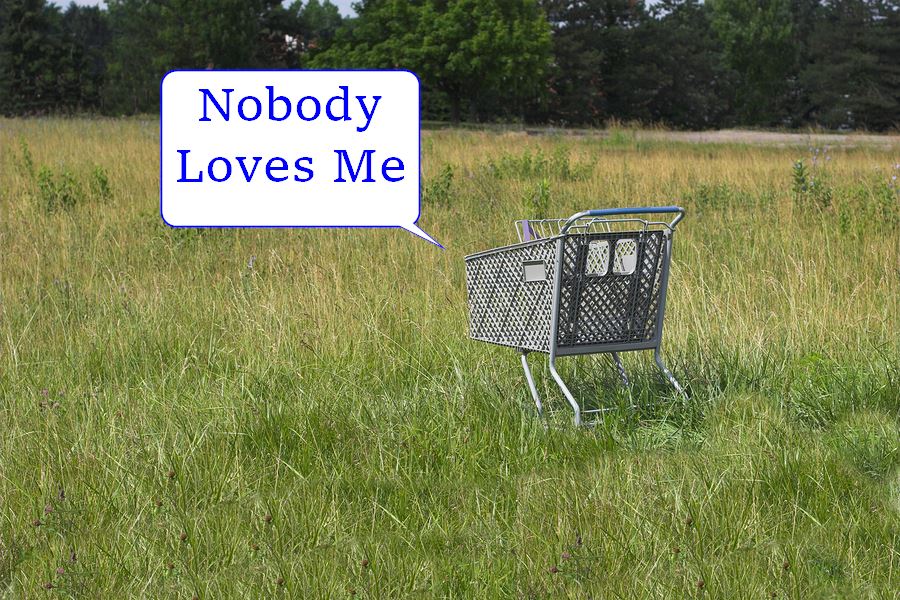
Images allow you to tap into your readers’ emotions. No, they don’t really care about a sad, lonely shopping cart, but the imagery inspires emotions like loss and disappointment.
Again, use product images, too. You want your readers to see what they are missing out on. Text alone won’t necessarily send your prospects running back to the virtual checkout line.
3. Use the Abandoned Items at the Start of the Email
A good way to prime your reader is to stick the image of the abandoned item and its description at the very top of the email. You can get to the details and CTA later.
Your reader will recognize the product. After all, they put it into the cart in the first place. That moment of recognition can inspire your reader to want the item again.
This doesn’t mean a headline can’t work, too. Test both strategies as you send out your abandoned cart emails to determine which gets the most conversions.
You May Also Like:
- 23 Email Marketing Statistics To Highly Increase Your Conversions
- Email Marketing For Beginners: A Complete Guide
4. Be Authentic and Clear — Remind People Of Your Brand Values
Staying true to your brand values and voice can make a huge difference in conversion rates. This is true with all marketing, especially with abandoned cart emails.
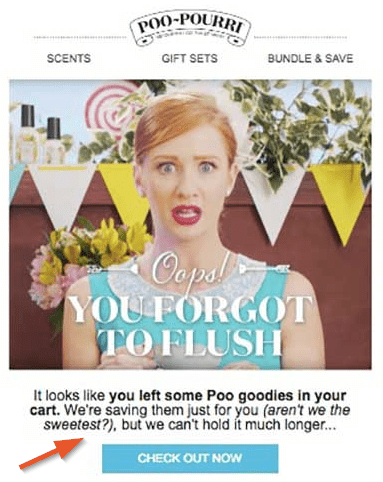
Add a dose of humor, use words that describe your brand (e.g., “sweetest”), and tell the truth (e.g., “we can’t hold it much longer…”). In other words, you want to remind people why they visited your site and added an item to their cart in the first place.
5. Address the Readers by Their Names
Personalizing your abandoned cart email can increase open rates and conversion rates. You want your readers to feel respected and appreciated.
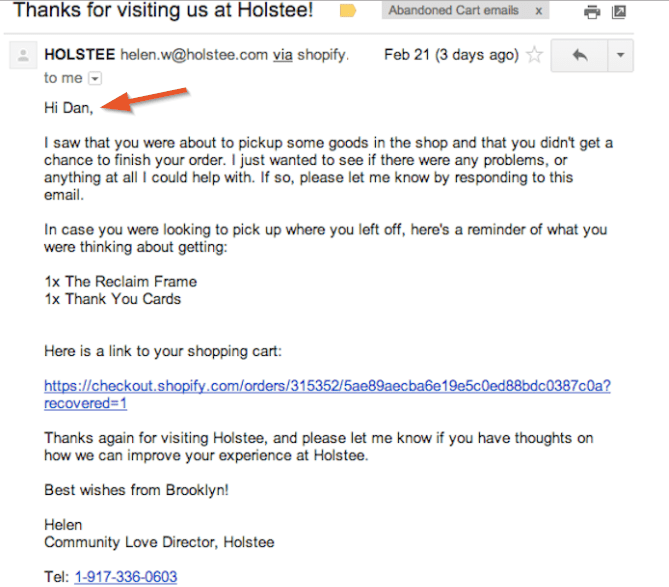
Consider addressing them by name in the subject line and email body. It’s a great way to establish rapport.
6. Appreciate the Reader For Adding Your Products to Their Shopping Carts
Gratitude goes a long way toward convincing someone to purchase something they’ve already abandoned. Thank the reader sincerely for visiting your website and selecting items from your inventory.
You don’t have to gush. A simple sentence or two will work just fine: “Thanks so much for visiting [Company Name] and adding [Product Name] to your cart. We appreciate your interest!”
7. Show the Reader How Unique Your Product Is and Why They Should Buy It
We mentioned earlier that people abandon their shopping carts for myriad reasons. Unfortunately, knowing why one particular customer abandoned a cart is impossible.
Consequently, you have to position your product in the best possible light. Focus on communicating value, ease of use, uniqueness, affordability, or quality. Of course, you can mix and match as you please.
The important thing is to give the reader a reason to reconsider the abandoned items. If you’re persuasive enough with your copywriting, you’ll generate far more conversions.
Look through some product descriptions on an ecommerce site you like. Read what the companies highlight about the product, then use that information to inform your email copywriting decisions.
8. Offer An Incentive in Your Abandoned Cart Emails
Another way to improve conversions on abandoned cart emails is to provide an additional incentive.
It could be a discount code, an offer for free shipping, a bundle deal, or anything else that adds more value to the transaction.
9. Use Customers Reviews and Testimonials in Your Abandoned Cart Emails
There’s nothing wrong with a little horn-tooting if it’s warranted. People often make decisions based on what others say about a product or service.
Again, put yourself in the customer’s shoes. If you’re shopping for a product on Amazon and you see the following two user rating stats, which one would you be more willing to buy?
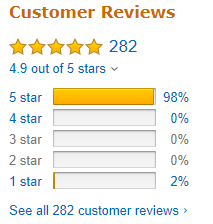
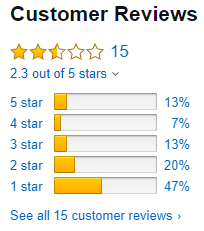
The first one, right? Not only does it have far more reviews, but it has a 4.9-star rating. The second only gets 2.3 stars.
Add reviews, testimonials, and other examples of social proof in your emails. Ensure they’re specifically about the product in question — otherwise, they’re useless.
10. Show Related Products and Wishlist Items in Your Abandoned Cart Emails
Maybe your prospect found a product they liked, but it just wasn’t quite right. You’ve had that experience before, so you can probably relate to the consumer.
Adding related products and highlighting wishlist items can help your reader decide to commit. For instance, maybe you have an upgraded form of the product your customer put in the cart. Suggest that product as an alternative because of X, Y, and Z extra features.
11. Use Humor in Your Abandoned Cart Emails If Appropriate
Some brands build their reputations on humor and a light, frothy approach to marketing. Others are more serious and prefer to leave humor out of the equation.
Only you can make that decision.
Often, you have to consider the customer. If there’s a chance your prospect might get offended or irritated by your stab at humor, resist the urge to be funny. If you think you’ll get a laugh, however, go ahead and unleash your inner comedian.
12. Send Your First Abandoned Cart Email Soon After the Abandonment
Timing matters when it comes to an abandoned cart email. If too much time lapses, your prospect has likely purchased the product from another vendor or decided against the purchase entirely.
Ideally, you don’t want more than 24 hours to lapse from when your prospect abandons the shopping cart and when you send your email. You watch to catch that person before they can go to the competition or think of more objections to the purchase.
You May Also Like:
- 17 Great Welcome Email Examples to Inspire Your Campaign
- Opt-In Email Marketing: 13 Best Practices To Better Results
13. Use a Sequence of Automated Emails to Increase Cart Recovery Chances
Email drip campaigns work well in ecommerce marketing. They’re instrumental in redirecting the reader to a major call to action, such as returning to a full shopping cart.
Plan a sequence of three to five emails, each sent the day before the last. You don’t want to get on your prospect’s nerves, which could eliminate their chances of returning to your site. At the same time, you want to give that person every opportunity to convert.
In each email, highlight something new about the product in question. For example, if you talk about value and quality in the first one, mention unique features in the second.
Your last one or two emails should include some type of incentive. For instance, you might offer a coupon, discount code, or free shipping regardless of the order’s cost.
14. Segment Your Email Sequences
Segmenting your abandoned cart emails can help increase your conversion rate even further. The message should align with the customer’s position in the sales funnel.
Use one segment for people who have never visited your site before. They might have stumbled across it during a Google search, added a product to the shopping cart, and decided against it.
Use this opportunity to introduce your brand in more detail and invite the reader to revisit your site to reconsider purchasing.
Create another segment for people who already subscribe to your newsletter. They’re brand-aware, so you can dig right into the conversion CTA. Mentioning their subscription might also help boost conversions.
Finally, maintain another sequence or single email for people who have already converted on other offers. If they’re existing customers, you might ask how they enjoyed their last purchase and invite them to return.
15. Make it Super Easy For Your Customers to Go Back to Your Checkout Page
You can’t underestimate simplicity when sending emails about abandoned shopping carts. If you complicate the process, most prospects will simply disregard the invitation.
Eliminate friction at every opportunity. For instance, let your customers check out as guests. That way, they don’t have to fill in many form fields, confirm their email addresses, and perform other tasks.
Additionally, your CTA should link directly to the user’s actual cart. Don’t make your prospect hunt for it — many won’t bother.
16. Constantly Test Your Emails and Calls to Action to Find Out What Works Best
Test, test, test. When you think you can’t test anything else, find something new.
At Hello Bar, we recommend A/B testing everything, regardless of what you’re offering on your website. Do the same with your emails.
17. Create Urgency Using a Countdown In Your Abandoned Cart Emails
A countdown is a great way to convey urgency. If the timer runs out, your website will automatically empty the user’s shopping cart.
Leveraging people’s fear of missing out is one of the smartest best practices for abandoned cart emails. People don’t want to lose something within their grasp, so if they desire your product, they’ll convert. The countdown timer serves as a visual reminder that your prospect doesn’t have all the time in the world.
18. Ensure Your Emails Are Mobile Friendly
Earlier in this article, I mentioned that abandoned shopping carts are far more common on mobile devices than on desktop. Consequently, you need your website as well as your email to be mobile friendly.
Use responsive design on your website and make sure your images are properly scaled in your emails. Don’t use a subject line that the reader can’t see on a mobile device, and avoid using heavy backgrounds or other elements that might slow email loading times.
Earlier in this article, we mentioned that abandoned shopping carts are far more common on mobile devices than desktops. Consequently, your website and email need to be mobile-friendly.
Use responsive design on your website and make sure your images are properly scaled in your emails. Don’t use a subject line that the reader can’t see on a mobile device, and avoid using heavy backgrounds or other elements that might slow email loading times.
19. Sprinkle in Some Cross-Selling Fun
Personalize your abandoned cart email sequence with cross-selling options to boost conversion rates.
It’s one of our favorite abandoned cart email best practices. It entices online shoppers to purchase more, helping to recover lost sales. In the this example, Oriental Trading leveraged the abandoned cart email.
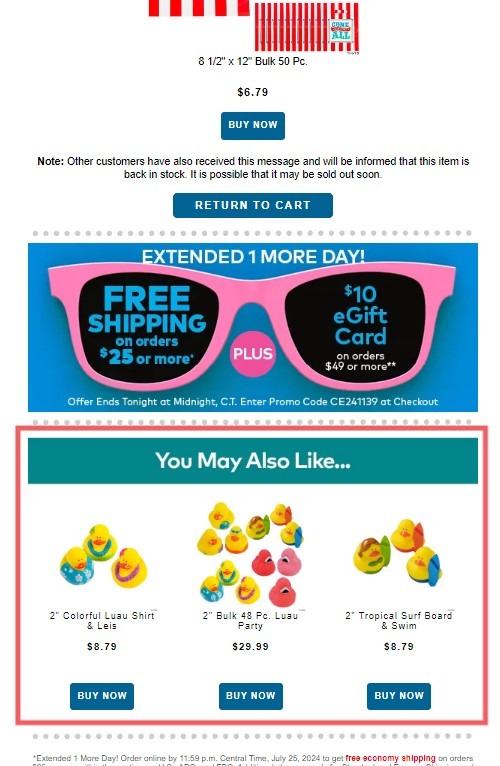
Image via Milled
Sweeten the deal by highlighting special offers, like free shipping on additional items, to motivate customers to finalize their purchase.
Abandoned Cart Email Examples
Now that you’re familiar with our 19 abandoned cart email best practices, let’s explore some excellent examples that might inspire you.
The first comes from Amazon, which is arguably one of the best at boosting ecommerce conversions.
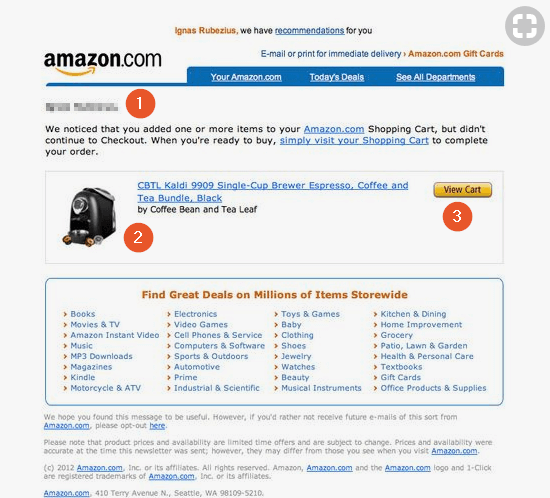
You can’t see it because we’ve blurred it out, but the email starts with the customer’s name. That’s a great way to personalize the email.
Amazon has included a photograph of the product abandoned in the cart, and a clear and visible CTA for the customer to “View Cart.” Although it’s not particularly inspired in terms of creativity, it gets the job done.
Next, we have an example from Wilderness Explorers.
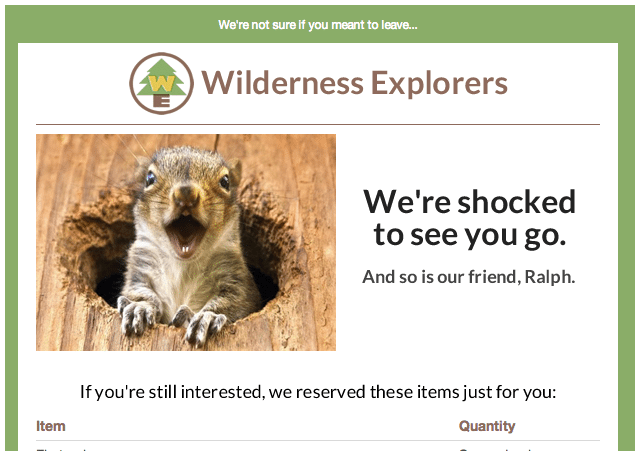
This is a prime example of an abandoned cart email done well with humor and brand authenticity. We have the cute photo, the humor in the headline, and the personalization with the phrase “just for you.” Although cropped, the email lists the items in the shopping cart so the reader can return and grab them.
You May Also Like:
- 51 Catchy Email Subject Lines Proven To Boost Conversions
- Best Email Subject Lines: Tips to Create Yours and 15 Great Examples
FAQs
Q1. Why are abandoned cart emails important for ecommerce businesses?
Abandoned cart emails help to:
- Recover lost sales by reminding customers they have abandoned carts.
- Increase conversion rates by encouraging online shoppers to return and finalize their transaction.
- Improve customer relationships and engagement as the abandoned cart messages offer an opportunity to re-engage with customers.
- Collect data on customer behavior and preferences
Q2. How successful are abandoned cart emails?
Abandoned cart emails are quite effective at recovering lost sales. They remind customers of their abandoned carts and encourage them to complete their purchase.
Q3. How many abandoned cart emails should I send?
Send the first email within 24 hours of cart abandonment and a follow-up email the next day. Then, another follow-up after three days and a final message a week later.
Q4. How can I improve the conversion rate of my abandoned cart emails?
Use abandoned cart email best practices such as personalizing the email content, including high-quality product images, offering free shipping or discounts, cross-selling, asking for feedback, and more.
Q5. What should I include in an abandoned cart email template?
An abandoned cart email template should include:
- A clear subject line
- A reminder of the items left behind with clear quality images
- Call to action to complete the purchase
- An offer like free shipping or a discount
- Personalized email content
Conclusion
An abandoned cart email, in many cases, represents cash in your pocket. It’s that important.
People abandon their virtual shopping carts for lots of reasons. They get distracted, change their minds, come up with questions or objections, or simply decide to return later.
Whatever the case, your email might draw them back to your site and give them an excuse to follow through with the purchase.
Some brands have experienced conversion rates of 3.66% using abandoned cart emails. If that’s not an incentive to try them, we don’t know what is. Bringing back that much business can impact your bottom line significantly.
Remember that you have to make it easy for the customer. Make a compelling case for buying the item or items in question, then show them exactly how to return to their cart and complete the checkout process.
Use abandoned cart email best practices like urgency, discounts, and free shipping help. Testing your emails so you know what works and what doesn’t is also essential.
Do you use abandoned cart emails for your business?




